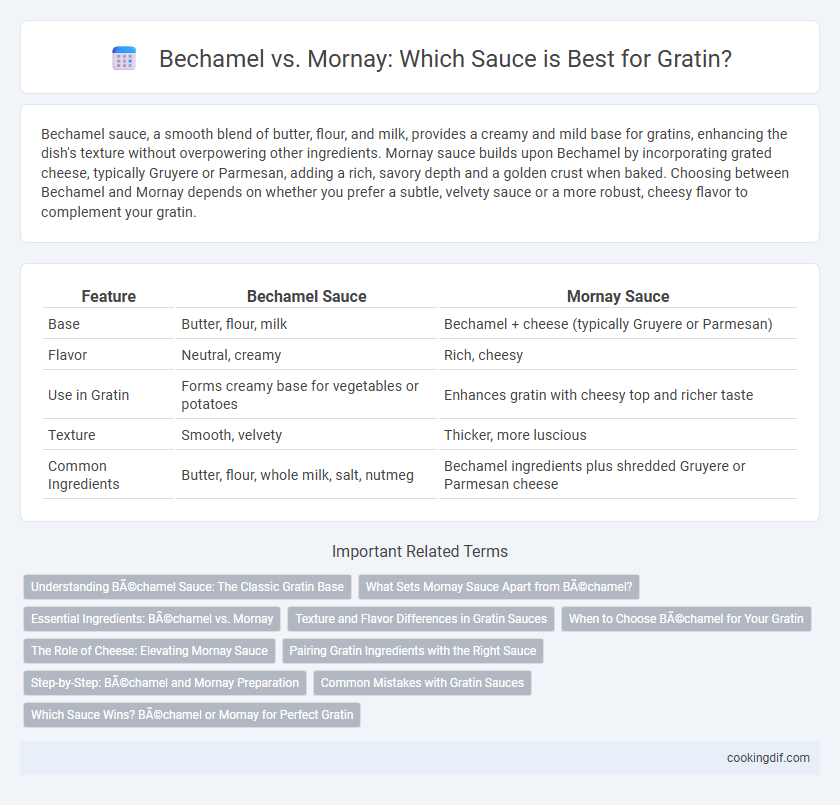Bechamel sauce, a smooth blend of butter, flour, and milk, provides a creamy and mild base for gratins, enhancing the dish's texture without overpowering other ingredients. Mornay sauce builds upon Bechamel by incorporating grated cheese, typically Gruyere or Parmesan, adding a rich, savory depth and a golden crust when baked. Choosing between Bechamel and Mornay depends on whether you prefer a subtle, velvety sauce or a more robust, cheesy flavor to complement your gratin.
Table of Comparison
| Feature | Bechamel Sauce | Mornay Sauce |
|---|---|---|
| Base | Butter, flour, milk | Bechamel + cheese (typically Gruyere or Parmesan) |
| Flavor | Neutral, creamy | Rich, cheesy |
| Use in Gratin | Forms creamy base for vegetables or potatoes | Enhances gratin with cheesy top and richer taste |
| Texture | Smooth, velvety | Thicker, more luscious |
| Common Ingredients | Butter, flour, whole milk, salt, nutmeg | Bechamel ingredients plus shredded Gruyere or Parmesan cheese |
Understanding Béchamel Sauce: The Classic Gratin Base
Bechamel sauce, a smooth blend of butter, flour, and milk, serves as the classic base for traditional gratins, providing a creamy and velvety texture essential for the dish's rich consistency. Mornay sauce, which is bechamel enriched with grated cheese such as Gruyere or Parmesan, adds a deeper flavor profile and golden crust ideal for gratins requiring extra richness and intensity. Understanding the role of bechamel versus Mornay sauce helps achieve the perfect balance between creamy smoothness and cheesy decadence in gratin preparations.
What Sets Mornay Sauce Apart from Béchamel?
Mornay sauce distinguishes itself from Bechamel by the addition of grated cheese, typically Gruyere or Parmesan, which imparts a rich, creamy texture and complex flavor perfect for gratin dishes. Unlike the basic Bechamel made with butter, flour, and milk, Mornay sauce elevates classic recipes by providing a savory, cheesy depth that enhances the dish's overall taste profile. This key difference makes Mornay sauce a preferred choice for gratins requiring a luscious, golden crust.
Essential Ingredients: Béchamel vs. Mornay
Bechamel sauce consists primarily of butter, flour, and milk, creating a smooth, creamy base essential for traditional gratin dishes. Mornay sauce builds on bechamel by adding grated cheese, typically Gruyere or Parmesan, which imparts a rich, savory depth and a golden crust when baked. The choice between bechamel and Mornay determines the gratin's texture and flavor profile, with Mornay offering a more indulgent and cheesy finish.
Texture and Flavor Differences in Gratin Sauces
Bechamel sauce provides a smooth, creamy texture with a mild, buttery flavor ideal for a classic gratin base. Mornay sauce enhances the gratin with a richer, silkier texture and a pronounced cheesy taste, thanks to the addition of Gruyere or Parmesan cheese. The choice between bechamel and Mornay impacts the overall mouthfeel and depth of flavor, with Mornay offering a more indulgent and savory profile.
When to Choose Béchamel for Your Gratin
Choose Bechamel sauce for your gratin when you want a smooth, creamy base with a mild, velvety texture that enhances the natural flavors of vegetables or poultry without overpowering them. Bechamel's simple blend of butter, flour, and milk creates a delicate foundation ideal for lighter dishes or when layering with cheese or other toppings for a subtle richness. Opting for Bechamel allows for better control over seasoning and texture, making it perfect for gratins where the focus is on the main ingredients rather than the sauce itself.
The Role of Cheese: Elevating Mornay Sauce
Mornay sauce distinguishes itself from Bechamel by incorporating grated cheese, typically Gruyere or Parmesan, which adds depth and richness essential for gratin dishes. The cheese melts into the creamy base, creating a velvety texture and a savory complexity that enhances the overall flavor profile. This cheesy element elevates Mornay sauce, making it the preferred choice for gratins that require a luxurious, golden-brown crust.
Pairing Gratin Ingredients with the Right Sauce
Bechamel sauce, a creamy blend of butter, flour, and milk, pairs perfectly with vegetable-based gratins like cauliflower or potato, enhancing their delicate flavors without overpowering. Mornay sauce, which adds melted cheese to bechamel, complements richer gratins featuring ingredients like ham, spinach, or seafood, providing a luscious, savory depth. Choosing between bechamel and Mornay hinges on balancing the gratin's core ingredients to achieve a harmonious texture and flavor profile.
Step-by-Step: Béchamel and Mornay Preparation
Bechamel sauce preparation begins with melting butter, whisking in flour to form a roux, and gradually adding warm milk while stirring continuously until smooth and thickened. To turn Bechamel into Mornay sauce, finely grated Gruyere and Parmesan cheeses are folded in just before serving, creating a rich, creamy texture ideal for gratins. Precise temperature control during milk incorporation and careful cheese melting ensure a silky consistency without curdling or graininess.
Common Mistakes with Gratin Sauces
Using bechamel sauce in gratin often leads to a common mistake of under-seasoning, resulting in a bland dish lacking depth. Mornay sauce, enriched with cheese, can curdle if overheated, causing an undesirable texture that compromises the smooth, creamy consistency essential for a perfect gratin. Over-thinning bechamel or misbalancing the cheese in Mornay also disrupts the sauce's ability to create the ideal gratin crust and cohesive flavor.
Which Sauce Wins? Béchamel or Mornay for Perfect Gratin
Mornay sauce, enriched with Gruyere or Parmesan cheese, triumphs over classic bechamel in gratin recipes due to its rich, creamy texture and enhanced flavor profile. Bechamel provides a smooth, velvety base with its blend of butter, flour, and milk, but lacks the cheesy depth that defines a perfect gratin. The cheese-infused Mornay sauce creates a golden, bubbly crust that elevates the dish, making it the preferred choice for achieving the ideal gratin.
Béchamel vs Mornay for sauce Infographic

 cookingdif.com
cookingdif.com